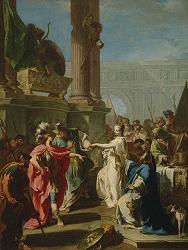Grades/Level: High School (9–12)
Subjects: Visual Arts, English–Language Arts
Time Required: Long–Term Unit
Six to seven 50-minute class periods plus independent work
Author: J. Paul Getty Museum Education Staff
Permissions: 
The lesson plan and downloadable materials on this page are licensed under a Creative Commons Attribution 4.0 International License. |
 |
|
 |
Students will analyze scenes from the Trojan War that are visually depicted in an ancient object and an 18th-century painting, especially the details depicted in the foreground, middle ground, and background. They will research an epic poem inspired by the Trojan War and write a literary response analyzing how themes and values in the poem reflect the historical context in which they were made. Finally, they will work in teams to reframe a tale from the Trojan War in a contemporary context—both visually and in poetry—and recite the tale in a poetry slam. |
 |
 |
 |
• Reproduction of Sarcophagus with Scenes from the Life of Achilles by an unknown Roman artist
• Reproduction of The Sacrifice of Polyxena by Giovanni Battista Pittoni
• Background Information and Questions for Teaching about the sarcophagus and painting
• Internet access
• Homer's Iliad
• Student Handout: "Homer, Oral Tradition, and the Trojan War"
• DVD player
• DVD excerpt of a modern-day retelling of the life of Achilles, such as scenes from Troy (dir. Wolfgang Petersen, 2004; rated R) or Helen of Troy (dir. John Kent Harrison, 2003; unrated) (Note: Please consult your school district's policy on watching excerpts of any films.)
• CD player (optional)
• Book and audio CD: The Spoken Word Revolution, edited by Mark Eleveld (Naperville, IL: Sourcebooks, Inc., 2003) (optional)
|
 |
 |
 |
Download the complete lesson by clicking on the "Download this lesson" icon above.
Glossary Terms:
Words in bold on these pages and in the lesson are defined in the glossary for this curriculum (see "Performing Arts in Art Contents" links above). |
 |
 |
 |
| The Sacrifice of Polyxena, Giovanni Battista Pittoni, about 1733–1734 |
 |
|
 |
Common Core Standards for English Language Arts
Grades 9–12
READING
Key Ideas and Details
1. Read closely to determine what the text says explicitly and to make logical inferences from it; cite specific textual evidence when writing or speaking to support conclusions drawn from the text.
2. Determine central ideas or themes of a text and analyze their development; summarize the key supporting details and ideas.
WRITING
Text Types and Purposes
1. Write arguments to support claims in an analysis of substantive topics or texts, using valid reasoning and relevant and sufficient evidence.
2. Write informative/explanatory texts to examine and convey complex ideas and information clearly and accurately through the effective selection, organization, and analysis of content.
Visual Arts Content Standards for California Public Schools
Grades 9–12 (Proficient)
3.0 Historical and Cultural Context
3.1 Identify similarities and differences in the purposes of art created in selected cultures.
3.3 Identify and describe trends in the visual arts and discuss how the issues of time, place, and cultural influence are reflected in selected works of art.
4.0 Aesthetic Valuing
4.1 Articulate how personal beliefs, cultural traditions, and current social, economic, and political contexts influence the interpretation of the meaning or message in a work of art.
4.2 Compare the ways in which the meaning of a specific work of art has been affected over time because of changes in interpretation and context.
5.0 Connections, Relationships, Applications
5.2 Create a work of art that communicates a cross-cultural or universal theme taken from literature or history.
English–Language Arts Content Standards for California Public Schools
Grades 9 and 10
Reading
3.0 Literary Response and Analysis
3.3 Analyze interactions between main and subordinate characters in a literary text (e.g., internal and external conflicts, motivations, relationships, influences) and explain the way those interactions affect the plot.
3.12 Analyze the way in which a work of literature is related to the themes and issues of its historical period. (Historical approach)
Writing
2.0 Writing Applications (Genres and Their Characteristics)
2.2 Write responses to literature:
a. Demonstrate a comprehensive grasp of the significant ideas of literary works.
b. Support important ideas and viewpoints through accurate and detailed references to the text or to other works.
c. Demonstrate awareness of the author's use of stylistic devices and an appreciation of the effects created.
Grades 11 and 12
Reading
3.0 Literary Response and Analysis
3.6 Analyze the way in which authors through the centuries have used archetypes drawn from myth and tradition in literature, film, political speeches, and religious writings (e.g., how the archetypes of banishment from an ideal world may be used to interpret Shakespeare's tragedy Macbeth).
3.7 Analyze recognized works of world literature from a variety of authors:
b. Relate literary works and authors to the major themes and issues of their eras.
c. Evaluate the philosophical, political, religious, ethical, and social influences of the historical period that shaped the characters, plots, and settings.
Writing
2.0 Writing Applications (Genres and Their Characteristics)
2.2 Write responses to literature:
a. Demonstrate a comprehensive understanding of the significant ideas in works or passages.
b. Analyze the use of imagery, language, universal themes, and unique aspects of the text.
c. Support important ideas and viewpoints through accurate and detailed references to the text and to other works.
d. Demonstrate an understanding of the author's use of stylistic devices and an appreciation of the effects created.
|
 |

|
 |